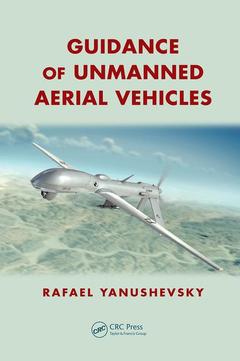Description
Guidance of Unmanned Aerial Vehicles
Author: Yanushevsky Rafael
Language: English
Subject for Guidance of Unmanned Aerial Vehicles:
Keywords
Guidance Law; law; PN; proportional; Miss Distance; navigation; PN Law; miss; PN Guidance; distance; Target Acceleration; target; Missile Acceleration; acceleration; Proportional Navigation Guidance Law; missile; Commanded Acceleration; line-of-sight; Effective Navigation Ratio; rate; Missile Guidance; Missile Guidance System; Los Rate; Pip; Adjoint System; Peak Miss; Homing Stage; Autopilot Design; Aerial Vehicle; Closing Velocity; KV; UAVs; Ts S; Boosting Motor; Rm Sm
Publication date: 03-2017
· 15.6x23.4 cm · Paperback
Publication date: 04-2011
360 p. · 15.6x23.4 cm · Hardback
Description
/li>Contents
/li>Readership
/li>Biography
/li>
Written by an expert with more than 30 years of experience, Guidance of Unmanned Aerial Vehicles contains new analytical results, taken from the author?s research, which can be used for analysis and design of unmanned aerial vehicles guidance and control systems. This book progresses from a clear elucidation of guidance laws and unmanned aerial vehicle dynamics to the modeling of their guidance and control systems.
Special attention is paid to guidance of autonomous UAVs, which differs from traditional missile guidance. The author explains UAV applications, contrasting them to a missile?s limited ability (or inability) to control axial acceleration. The discussion of guidance laws for UAVs presents a generalization of missile guidance laws developed by the author. The computational algorithms behind these laws are tested in three applications?for the surveillance problem, the refueling problem, and for the motion control of a swarm of UAVs. The procedure of choosing and testing the guidance laws is also considered in an example of future generation of airborne interceptors launched from UAVs.
The author provides an innovative presentation of the theoretical aspects of unmanned aerial vehicles? guidance that cannot be found in any other book. It presents new ideas that, once crystallized, can be implemented in the new generation of unmanned aerial systems.
Basics of Guidance. Control of Lateral Motion. Control of Longitudinal and Lateral Motions. Analysis of Proportional Navigation Guided Systems in Time Domain. Analysis of Proportional Navigation Guided Systems in the Frequency Domain. Design of Guidance Laws Implementing Parallel Navigation: Frequency-Domain Approach. Guidance Law Performance Analysis Under Stochastic Inputs. Guidance of UAVs. Testing Guidance Laws Performance. Integrated Design. Guidance Laws for Boost-Phase Interceptors Launched from UAVs. Appendices.
Rafael Yanushevsky was born in Kiev, Ukraine. He received a BS in mathematics and a MS (with honors) in electromechanical engineering from Kiev University and the Kiev Polytechnic Institute, respectively. He earned a Ph.D in optimization of multivariable systems in 1968 from the Institute of Control Sciences of the USSR Academy of Sciences, Moscow, Russia. After immigration to the United States in December 1987, he started teaching at the University of Maryland, first in the Department of Electrical Engineering, then in the Department of Mechanical Engineering, He also taught at the University of the District of Columbia in the Department of Mathematics. Since 1999, Dr. Yanushevsky has been involved in projects related to the aerospace industry.
These books may interest you

Design of Unmanned Aerial Systems 139.64 €



